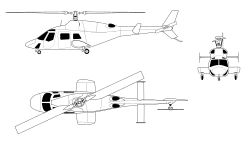| Bell 222/230 | |
|---|---|
 A Bell 222U | |
| General information | |
| Type | Executive/utility helicopter |
| National origin | United States |
| Manufacturer | Bell Helicopter |
| Number built | Bell 222: 199 Bell 230: 38 [1] |
| History | |
| Manufactured | Bell 222: 1980–1991 Bell 230: 1992–1995 |
| Introduction date | Bell 222: 1979 Bell 230: 1991 |
| First flight | Bell 222: 13 August 1976 Bell 230: 12 August 1991 |
| Variants | Bell 430 |
| Developed into | Bell D-292 |
The Bell 222 is an American twin-engine light helicopter built by Bell Helicopter. The Bell 230 is an improved development with different engines and other minor changes.





